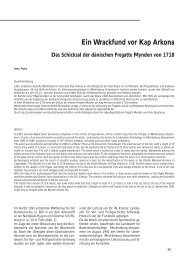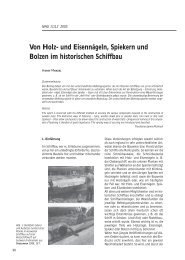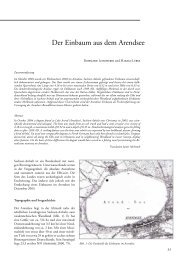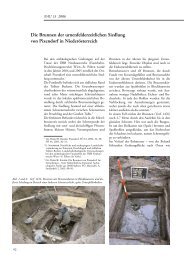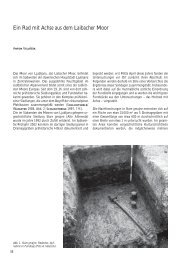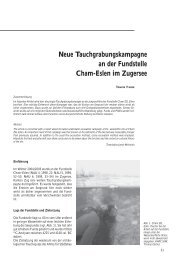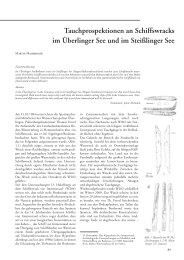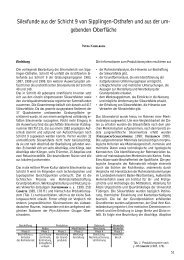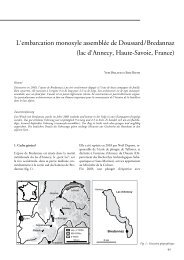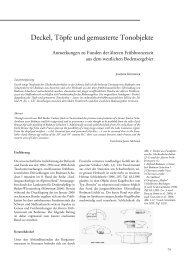Documents - Janus Verlag
Documents - Janus Verlag
Documents - Janus Verlag
Sie wollen auch ein ePaper? Erhöhen Sie die Reichweite Ihrer Titel.
YUMPU macht aus Druck-PDFs automatisch weboptimierte ePaper, die Google liebt.
Skin versus Wood? Probably both!Norwegian Early Mesolithic Boat TechnologyJames McCleanAbstractThis paper proposes a multi-faceted answer to the Skin versus Wood debate that has been the subject of much inkthroughout the mid and late 20 th century among archaeologists concerning the types of watercraft in use throughoutearly post glacial colonisation of Scandinavian. Rather than endorse a polarised view in which only a single vessel typeis recognised as in use throughout prehistoric Scandinavia, this paper proposes that skin boats likely predominated inthe far north without leaving a continuing legacy, while wooden dugouts evolved raised strake boards towards the endof the Mesolithic in the southern Baltic region as better wood working tools were developed culminating in vessels likethe Hjortspring boat find of the early Iron Age. These conclusions are based upon a synthesis of research concerningrock carvings with marine motifs, palynalogical studies for early post glacial Scandinavia and ethnographic andarchaeological records of boat types in use throughout north west Europe. This paper is a very brief summary of aMasters Thesis completed in 2002 at Florida State University entitled “An Investigation of Northwest EuropeanMesolithic Boat Technology”.IntroductionWhile dugout canoes are the most widely representedboat types for the later Mesolithic inSouthern Scandinavia, very little is known ofboat technology used by the early Mesolithicpostglacial colonists to Norway. The earliestunequivocal boat remains from northern Europeare those of later Mesolithic dugout canoes,the oldest being a dugout canoe from Pesse inthe Netherlands, dated to 6300 BC (McGrail1998; Smith 1992). In addition, a number ofother late Mesolithic dugout canoes are knownfrom Danish, Northern Irish, Dutch and Germansites (Andersen 1985; id. 1987; 1994;Christensen 1990; Fry 2000; Lübke 2000).However, indirect evidence for boat use at Norwegianisland sites indicates that boat technologyextends back to early Mesolithic cultures.Several theories concerning early Mesolithicboat technology have been proposed, manybased upon considerations of rock art imageryfrom Scandinavia containing boat motifs. The“Skin versus Wood” debate has been an attemptto classify early Mesolithic boat technology aseither a skin or wooden boat building tradition.Skin boat proponents advocate a boat technologysimilar to Inuit umiaks and kayaks (Brøgger/Shetelig1951; Crumlin-Pedersen 1970;Gjessing 1936; Ellmers 1980; id. 1984; 1986;Stölting 1997). Other scholars have proposedthat dugout canoe technology has always beenthe predominant boat tradition throughout theMesolithic (Greenhill 1976; R ausing 1984).This paper proposes that the answer is not to befound in the highly developed skin boats of theEskimo and other polar tribes, but rather in theBritish Isles. It is here proposed that a skin boattechnology similar to Irish curraghs was in usealong the coastal settlements of northern Norwayduring the early Mesolithic.Boat Imagery as an Indicator ofMaritime TechnologyGutorm Gjessing was the first to cite rock artimagery as evidence for skin boat technologyduring the Mesolithic along Norway’s coast.The ideas developed in Gjessing’s essay were advancedfor the early 1930’s when they were written.Unfortunately at that time chronology andaccurate dating of these images was based onlyupon stylistic analysis of the imagery. Since theappearance of Gjessing’s and Hallström’s respectivecatalogues of Norwegian and Swedish rockart (Gjessing 1936; id. 1958; Hallström 1960),there has been a tremendous amount of researchon this topic. The 1970’s and 1980’s witnessednew interpretations of these images in terms ofsemiotic and contextual theory (Kuhn 1967;Malmer 1981; Tilley 1991). Refinements were9




